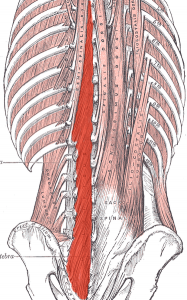 A while back I wrote about the psoas and its next door neighbor the quadratus lumborum.
A while back I wrote about the psoas and its next door neighbor the quadratus lumborum.
I think issues with the quadratus are responsible for a great deal of back pain and tightness.
Today we’ll talk about the multifidus muscle.
The multifidus muscle is actually a series of muscles attached to the spinal column, divided into two groups which include the superficial muscle group and the deep muscle group.
They help to take pressure off the discs of the spine allowing the weight of the upper body to be successfully distributed along the spine.
The superficial muscle group keeps the spine straight while the deep muscle group helps with the spine’s stability.
These amazing muscles anticipate your behavior.
If you cough, the mutifidus muscles engage to stabilize the spine before the cough occurs.
The same thing happens when you prepare to lift something.
If you have ever heard of someone who throws their back out when they sneeze, it is likely because of weakness in the mulitifidus muscle and other assorted muscles that stabilize the pelvis and low spine.
The multifidus muscle is involved in almost every yoga pose so I don’t have to mention it all the time but you can be sure that you are trying to use it well in most movements you make.
All of the walking and standing work, and the exercises I recommend for lengthening and toning the muscles of the lower back, apply to the multifidus. I often talk about the psoas and quadratus lumborum as the trouble spots and while they are, the multifidus almost always factors in, in a similar way.
If your lower back is short and tight the way I think most everyone’s is, then the multifidus, along with the quadratus lumborum will probably have trouble finding length and tone and engaging as it should.
So there you have it. Build tone in your multifidus and you won’t regret it.
